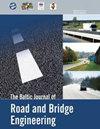Experimental Method of Fatigue Performance of Mastic Asphalt for Bridge Deck Pavement
IF 1.1
4区 工程技术
Q4 ENGINEERING, CIVIL
引用次数: 7
Abstract
Mastic asphalt is a type of pavement material that has good fluidity and is self-levelling at construction temperature for the bridge deck. There are highly accurate methods and indexes for evaluating fluidity and high-temperature deformation resistance for mastic asphalt-design and construction-control systems. The fatigue cracking is one of the main failure forms of bridge deck pavement. Therefore, the method used to evaluate the fatigue properties of pavement materials is also essential. The anti-deformation capability of the mastic asphalt must be increased, that results in poor fatigue performance and consequent failure of the bridge deck pavement to avoid the rutting of bridge deck pavement. In this study, a simple method is put forward for evaluating mastic asphalt fatigue performance. Impact toughness is defined as the area under the load-displacement curve of a three-point bending beam specimen under impact load to evaluate the fatigue performance of mastic asphalt. The four-point bending beam fatigue test is used to verify the rationality of the impact toughness test method. The results showed that there is a good correlation between the impacts toughness index of mastic asphalt produced under different mixing conditions and the accumulative dissipative energy and fatigue life demonstrated by the four-point bending beam test. Therefore, to evaluate the fatigue performance of mastic asphalt by impact toughness test. Fatigue performance and rut resistance are two ways to evaluate road performance of asphalt mixtures, but they are mutually restrictive. The results show that impact toughness and dynamic stability are inversely correlated. As the impact toughness increases, dynamic stability decreases. Therefore, balancing the fatigue performance and high-temperature rutting resistance of mastic asphalt in the design and quality control is very important.桥面铺装用沥青疲劳性能的试验方法
Mastic沥青是一种具有良好流动性的路面材料,在施工温度下可用于桥面自流平。对于沥青胶料的设计和施工控制系统,有非常准确的方法和指标来评估流动性和耐高温变形性。疲劳开裂是桥面铺装的主要失效形式之一。因此,用于评估路面材料疲劳性能的方法也是必不可少的。为了避免桥面铺装产生车辙,必须提高沥青玛蹄脂的抗变形能力,这会导致桥面铺装的疲劳性能较差,进而导致桥面铺装失效。在本研究中,提出了一种简单的方法来评估沥青胶浆的疲劳性能。冲击韧性定义为三点弯曲梁试样在冲击载荷下的载荷-位移曲线下的面积,以评估沥青胶的疲劳性能。采用四点弯曲梁疲劳试验验证了冲击韧性试验方法的合理性。结果表明,在不同搅拌条件下生产的玛蹄脂沥青的冲击韧性指数与四点弯曲梁试验显示的累积耗散能和疲劳寿命之间存在良好的相关性。因此,通过冲击韧性试验来评价沥青玛蹄脂的疲劳性能。疲劳性能和抗车辙性能是评价沥青混合料路用性能的两种方法,但它们相互制约。结果表明,冲击韧性与动态稳定性呈负相关。随着冲击韧性的增加,动态稳定性降低。因此,在设计和质量控制中,平衡胶浆沥青的疲劳性能和耐高温车辙性能是非常重要的。
本文章由计算机程序翻译,如有差异,请以英文原文为准。
求助全文
约1分钟内获得全文
求助全文
来源期刊
CiteScore
2.10
自引率
9.10%
发文量
25
审稿时长
>12 weeks
期刊介绍:
THE JOURNAL IS DESIGNED FOR PUBLISHING PAPERS CONCERNING THE FOLLOWING AREAS OF RESEARCH:
road and bridge research and design,
road construction materials and technologies,
bridge construction materials and technologies,
road and bridge repair,
road and bridge maintenance,
traffic safety,
road and bridge information technologies,
environmental issues,
road climatology,
low-volume roads,
normative documentation,
quality management and assurance,
road infrastructure and its assessment,
asset management,
road and bridge construction financing,
specialist pre-service and in-service training;

 求助内容:
求助内容: 应助结果提醒方式:
应助结果提醒方式:


